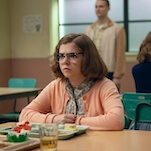Naoko Yamada On Her Latest Film The Colors Within and Why She Creates
Photo Courtesy of GKIDS
If you’re deeply invested in the world of anime, there’s a good chance you’ve heard the name Naoko Yamada, the director and animator behind series like K-On! and Heike Story, as well as the films A Silent Voice and Liz and the Blue Bird. Having entered the industry through the acclaimed studio Kyoto Animation, she quickly rose to the position of director thanks to her ability to tease out the inner lives of her characters, using body language and other subtle animation details to capture how they feel. Her latest film, The Colors Within, fits in perfectly with the rest of her oeuvre, a picturesque coming-of-age movie about music and growing up that follows a girl named Totsuko who “sees other people as colors,” somewhat similar to synesthesia. We got a chance to talk with Yamada about her latest film, why she’s drawn to stories about bands, and what inspires her to be an animator.
(Note: This interview was conducted via a translator)
Paste Magazine: Much of The Colors Within is about Totsuko navigating the fact that she sees the world differently than other people. Can you tell me a bit about what inspired that idea?
Naoko Yamada: Yeah, so as for why I made this film, I don’t know how it is in the United States, but I think in Asia or in Japan, I think everyone tends to categorize people and put them in specific teams, groups, or boxes. As in, “ You’re like this kind of person, so you’re in that kind of a group, and then you’re not, so you’re in this kind of group.” And so I think that’s interesting, but I also think what about the people who don’t fit into that specific frame or box? I think we’ve forgotten people’s individuality. I started thinking about that, and that was the beginning of what came of this movie. I think I wanted to depict characters who don’t fit inside of a box that others have categorized, so they may have emotions or individual characteristics that you can’t put a name on. So I wanted to make viewers feel “I don’t understand, but I like this person.” And I think that sort of led to her seeing people through colors, which is the specific characteristic and form of individuality I assigned to her to demonstrate that idea.
Paste: What were some of your biggest influences for your latest film, whether that’s other movies, anime, literature, or anything else?
Yamada: So, there was this documentary about a specific cathedral where, for 30 years, filming and photography weren’t allowed inside, but then they finally let a group make a documentary about it. It’s called Into Great Silence. So I watched it, and then I started thinking about its imagery and what I sensed from the film. You have these long corridors and footsteps where you sort of sense people, but everyone is trying to keep quiet. That sense of quietness was a huge influence on this movie.
Paste: When it comes to much of your work, there’s a focus on bands, like in The Colors Within, as well as your TV series, like Sound Euphonium!, K-On, and more. What makes you interested in stories about people making music?
Yamada: What I clearly know about myself is that I love and adore music. And not just the music itself but also musicians. I respect and adore them because I can’t make music or play instruments that well. So I think through my works, through my characters practicing, learning, and playing music, I’m sort of living through them and getting the feeling of making music through them. And another thing about music is that it doesn’t matter your nationality, age, or gender; it’s really a universal language. I think that’s also very, very important.
Paste: A throughline in the anime you’ve directed is an emphasis on subtle details, like a focus on quotidian concerns, character animation, small changes in body language, and so on. Considering how many other anime focuses on large-scale action scenes, what drives you to make more grounded stories instead?






































